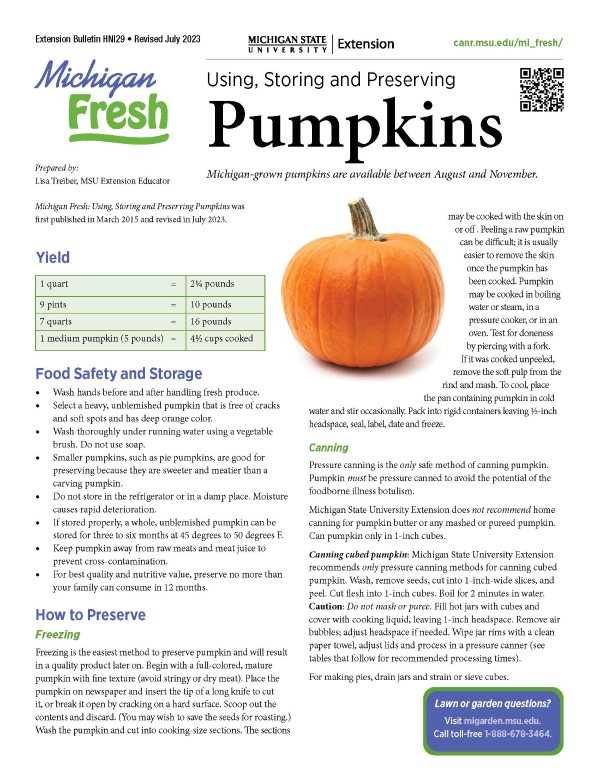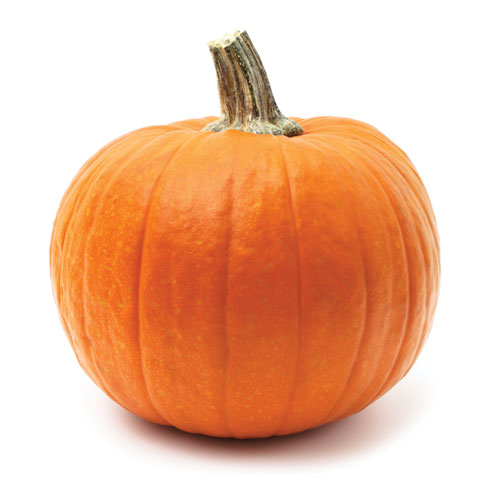
Michigan Fresh: Using, Storing, and Preserving Pumpkins (HNI29)
DOWNLOADJuly 18, 2023 - Lisa Treiber, Michigan State University Extension
This Document is offered in: English, Arabic Espanol,
Yield
|
1 quart = |
2¼ pounds |
|
9 pints = |
10 pounds |
|
7 quarts = |
16 pounds |
|
1 medium pumpkin (5 pounds) = |
4½ cups cooked |
Food Safety and Storage

- Wash hands before and after handling fresh produce.
- Select a heavy, unblemished pumpkin that is free of cracks and soft spots and has deep orange color.
- Wash thoroughly under running water using a vegetable brush. Do not use soap.
- Smaller pumpkins, such as pie pumpkins, are good for preserving because they are sweeter and meatier than a carving pumpkin.
- Do not store in the refrigerator or in a damp place. Moisture causes rapid deterioration.
- If stored properly, a whole, unblemished pumpkin can be stored for three to six months at 45 degrees to 50 degrees F.
- Keep pumpkin away from raw meats and meat juice to prevent cross-contamination.
- For best quality and nutritive value, preserve no more than your family can consume in 12 months.
How to Preserve
Freezing
Freezing is the easiest method to preserve pumpkin and will result in a quality product later on. Begin with a full-colored, mature pumpkin with fine texture (avoid stringy or dry meat). Place the pumpkin on newspaper and insert the tip of a long knife to cut it, or break it open by cracking on a hard surface. Scoop out the contents and discard. (You may wish to save the seeds for roasting.) Wash the pumpkin and cut into cooking-size sections. The sections may be cooked with the skin on or off. Peeling a raw pumpkin can be difficult; it is usually easier to remove the skin once the pumpkin has been cooked. Pumpkin may be cooked in boiling water or steam, in a pressure cooker, or in an oven. Test for doneness by piercing with a fork. If it was cooked unpeeled, remove the soft pulp from the rind and mash. To cool, place the pan containing pumpkin in cold water and stir occasionally. Pack into rigid containers leaving ½-inch headspace, seal, label, date and freeze.
Canning
Pressure canning is the only safe method of canning pumpkin. Pumpkin must be pressure canned to avoid the potential of the foodborne illness botulism.
Michigan State University Extension does not recommend home canning for pumpkin butter or any mashed or pureed pumpkin. Can pumpkin only in 1-inch cubes.
Canning cubed pumpkin: Michigan State University Extension recommends only pressure canning methods for canning cubed pumpkin. Wash, remove seeds, cut into 1-inch-wide slices, and peel. Cut flesh into 1-inch cubes. Boil for 2 minutes in water. Caution: Do not mash or puree. Fill hot jars with cubes and cover with cooking liquid, leaving 1-inch headspace. Remove air bubbles; adjust headspace if needed. Wipe jar rims with a clean paper towel, adjust lids and process in a pressure canner (see tables that follow for recommended processing times).
For making pies, drain jars and strain or sieve cubes.
|
Recommended process time (in minutes) for pumpkin in a dial-gauge pressure canner. |
||||||
|
|
Canner pressure (PSI) at altitudes of |
|||||
|
Style of pack |
Jar size |
Process time |
0 – 2,000 ft |
2,001 – 4,000 ft |
4,001 – 6,000 ft |
6,001 – 8,000 ft |
|
Hot |
Pints |
55 |
11 lb. |
12 lb. |
13 lb. |
14 lb. |
|
Quarts |
90 |
11 lb. |
12 lb. |
13 lb. |
14 lb. |
|
|
Recommended process time (in minutes) for pumpkin in a weighted-gauge pressure canner. |
||||
|
|
Canner pressure (PSI) at altitudes of |
|||
|
Style of pack |
Jar size |
Process time |
0 – 1,000 ft |
Above 1,000 ft |
|
Hot |
Pints |
55 |
10 lb. |
15 lb. |
|
Quarts |
90 |
10 lb. |
15 lb. |
|
Let jars sit undisturbed for 12 to 24 hours, check lids to be sure they’ve sealed, remove rings, wash jars, date, label and store. Food in jars that do not seal must be reprocessed in a clean jar with a new lid within 24 hours, refrigerated or frozen.
Tables were adapted from the Complete Guide to Home Canning: Guide 4: Selecting, Preparing and Canning Vegetables and Vegetable Products, USDA, 2015, p. 18. https://nchfp.uga.edu/publications/publications_usda.html#gsc.tab=0
Drying pumpkin and pumpkin seeds
Wash, peel and remove fibers and seeds from pumpkin flesh. Cut flesh into small, thin strips no more than 1-inch wide by ⅛-inch thick. Blanch strips over steam for 3 minutes and dip briefly in cold water to stop the blanching process. You do not need to cool to room temperature before drying. Drain excess moisture. Dry the strips in an electric dehydrator until brittle.
Pumpkin also makes excellent dried vegetable leather. Puree cooked pumpkin and strain. Add honey and spices, and dry in a home food dehydrator.
Drying seeds and roasting seeds are different processes. To dry, wash pumpkin seeds, removing fibrous pumpkin tissue. Then dry seeds in the sun, in an electric dehydrator at 115 degrees to120 degrees F for 1 to 2 hours, or in an oven on a very low, warm temperature only for 3 to 4 hours. Stir frequently to avoid scorching. Dried seeds need to be stored in a moisture-free environment.
To roast seeds, take the dried seeds, toss with oil, salt, or both, and roast in a preheated oven at 250 degrees F for 10 to 15 minutes, stirring occasionally. Store in an airtight container.
Sources
- Andress, E., & Harrison, J. A. (2014). So easy to preserve (Bulletin 989). (6th ed.). University of Georgia Cooperative Extension.
- U.S. Department of Agriculture. (2015). Complete guide to home canning (Rev. ed.). (Agriculture Information Bulletin No. 539). http://nchfp.uga.edu/publications/publications_usda.html
More information



 Print
Print Email
Email




